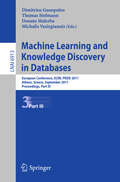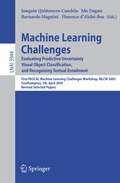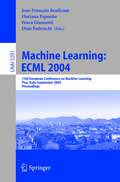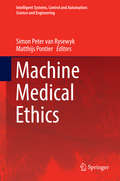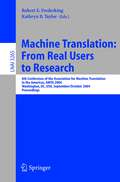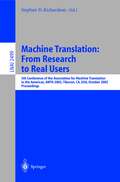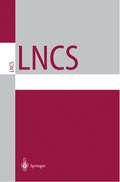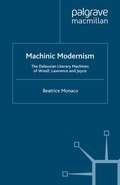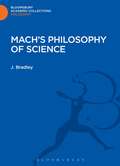- Table View
- List View
Machine Learning and Knowledge Discovery in Databases, Part III: European Conference, ECML PKDD 2010, Athens, Greece, September 5-9, 2011, Proceedings, Part III (Lecture Notes in Computer Science #6913)
by Dimitrios Gunopulos Thomas Hofmann Donato Malerba Michalis VazirgiannisThis three-volume set LNAI 6911, LNAI 6912, and LNAI 6913 constitutes the refereed proceedings of the European conference on Machine Learning and Knowledge Discovery in Databases: ECML PKDD 2011, held in Athens, Greece, in September 2011. The 121 revised full papers presented together with 10 invited talks and 11 demos in the three volumes, were carefully reviewed and selected from about 600 paper submissions. The papers address all areas related to machine learning and knowledge discovery in databases as well as other innovative application domains such as supervised and unsupervised learning with some innovative contributions in fundamental issues; dimensionality reduction, distance and similarity learning, model learning and matrix/tensor analysis; graph mining, graphical models, hidden markov models, kernel methods, active and ensemble learning, semi-supervised and transductive learning, mining sparse representations, model learning, inductive logic programming, and statistical learning. a significant part of the papers covers novel and timely applications of data mining and machine learning in industrial domains.
Machine Learning Challenges: Evaluating Predictive Uncertainty, Visual Object Classification, and Recognizing Textual Entailment, First Pascal Machine Learning Challenges Workshop, MLCW 2005, Southampton, UK, April 11-13, 2005, Revised Selected Papers (Lecture Notes in Computer Science #3944)
by Joaquin Quinonero-Candela Ido Dagan Bernardo Magnini Florence D'Alché-BucThis book constitutes the refereed post-proceedings of the First PASCAL Machine Learning Challenges Workshop, MLCW 2005. 25 papers address three challenges: finding an assessment base on the uncertainty of predictions using classical statistics, Bayesian inference, and statistical learning theory; second, recognizing objects from a number of visual object classes in realistic scenes; third, recognizing textual entailment addresses semantic analysis of language to form a generic framework for applied semantic inference in text understanding.
Machine Learning: 15th European Conference on Machine Learning, Pisa, Italy, September 20-24, 2004, Proceedings (Lecture Notes in Computer Science #3201)
by Jean-François Boulicaut Floriana Esposito Fosca Giannotti Dino PedreschiMachine Medical Ethics (Intelligent Systems, Control and Automation: Science and Engineering #74)
by Simon Peter van Rysewyk Matthijs PontierThe essays in this book, written by researchers from both humanities and science, describe various theoretical and experimental approaches to adding medical ethics to a machine, what design features are necessary in order to achieve this, philosophical and practical questions concerning justice, rights, decision-making and responsibility in medical contexts, and accurately modeling essential physician-machine-patient relationships.In medical settings, machines are in close proximity with human beings: with patients who are in vulnerable states of health, who have disabilities of various kinds, with the very young or very old and with medical professionals. Machines in these contexts are undertaking important medical tasks that require emotional sensitivity, knowledge of medical codes, human dignity and privacy.As machine technology advances, ethical concerns become more urgent: should medical machines be programmed to follow a code of medical ethics? What theory or theories should constrain medical machine conduct? What design features are required? Should machines share responsibility with humans for the ethical consequences of medical actions? How ought clinical relationships involving machines to be modeled? Is a capacity for empathy and emotion detection necessary? What about consciousness?This collection is the first book that addresses these 21st-century concerns.
Machine Translation: 6th Conference of the Association for Machine Translation in the Americas, AMTA 2004, Washington, DC, USA, September 28-October 2, 2004, Proceedings (Lecture Notes in Computer Science #3265)
by Robert E. Frederking Kathryn B. TaylorThe previous conference in this series (AMTA 2002) took up the theme “From Research to Real Users”, and sought to explore why recent research on data-driven machine translation didn’t seem to be moving to the marketplace. As it turned out, the ?rst commercial products of the data-driven research movement were just over the horizon, andintheinterveningtwoyearstheyhavebeguntoappearinthemarketplace. Atthesame time,rule-basedmachinetranslationsystemsareintroducingdata-driventechniquesinto the mix in their products. Machine translation as a software application has a 50-year history. There are an increasing number of exciting deployments of MT, many of which will be exhibited and discussed at the conference. But the scale of commercial use has never approached the estimates of the latent demand. In light of this, we reversed the question from AMTA 2002, to look at the next step in the path to commercial success for MT. We took user needs as our theme, and explored how or whether market requirements are feeding into research programs. The transition of research discoveries to practical use involves te- nicalquestionsthatarenotassexyasthosethathavedriventheresearchcommunityand research funding. Important product issues such as system customizability, computing resource requirements, and usability and ?tness for particular tasks need to engage the creativeenergiesofallpartsofourcommunity,especiallyresearch,aswemovemachine translation from a niche application to a more pervasive language conversion process. Thesetopicswereaddressedattheconferencethroughthepaperscontainedinthesep- ceedings, and even more speci?cally through several invited presentations and panels.
Machine Translation: 5th Conference of the Association for Machine Translation in the Americas, AMTA 2002 Tiburon, CA, USA, October 6-12, 2002. Proceedings (Lecture Notes in Computer Science #2499)
by Stephen D. RichardsonAMTA 2002: From Research to Real Users Ever since the showdown between Empiricists and Rationalists a decade ago at TMI 92, MT researchers have hotly pursued promising paradigms for MT, including da- driven approaches (e.g., statistical, example-based) and hybrids that integrate these with more traditional rule-based components. During the same period, commercial MT systems with standard transfer archit- tures have evolved along a parallel and almost unrelated track, increasing their cov- age (primarily through manual update of their lexicons, we assume) and achieving much broader acceptance and usage, principally through the medium of the Internet. Webpage translators have become commonplace; a number of online translation s- vices have appeared, including in their offerings both raw and postedited MT; and large corporations have been turning increasingly to MT to address the exigencies of global communication. Still, the output of the transfer-based systems employed in this expansion represents but a small drop in the ever-growing translation marketplace bucket.
Machine Translation and the Information Soup: Third Conference of the Association for Machine Translation in the Americas, AMTA’98, Langhorne, PA, USA, October 28–31, 1998 Proceedings (Lecture Notes in Computer Science #1529)
by David Farwell Laurie Gerber Eduard HovyMachine Translation and the Information Soup! Over the past fty years, machine translation has grown from a tantalizing dream to a respectable and stable scienti c-linguistic enterprise, with users, c- mercial systems, university research, and government participation. But until very recently, MT has been performed as a relatively distinct operation, so- what isolated from other text processing. Today, this situation is changing rapidly. The explosive growth of the Web has brought multilingual text into the reach of nearly everyone with a computer. We live in a soup of information, an increasingly multilingual bouillabaisse. And to partake of this soup, we can use MT systems together with more and more tools and language processing technologies|information retrieval engines, - tomated text summarizers, and multimodal and multilingual displays. Though some of them may still be rather experimental, and though they may not quite t together well yet, it is clear that the future will o er text manipulation systems that contain all these functions, seamlessly interconnected in various ways.
The Machinery of Government: Public Administration and the Liberal State
by Joseph HeathIn political theory, the traditional model of state power was that elected officials make policy decisions which are then faithfully executed by a lower cadre of public servants. The complexity of the modern state, however, leaves this model outdated. The vast number of economic and social problems it confronts is such that a great deal of rule-making power is now delegated to a class of civil servants. Yet many political philosophers have not taken this model up, and the field has ignored the important role played by the class of "permanent" state officials--the "deep state" as some call it--in liberal states. In most liberal democracies for example, the central bank is as independent as the supreme court, yet deals with a wide range of economic, social, and political issues. How do these public servants make these policy decisions? What normative principles inform their judgments? In The Machinery of Government, Joseph Heath attempts to answer these questions. He looks to the actual practice of public administration to see how normative questions are addressed. More broadly, he attempts to provide the outlines of a "philosophy of the executive" by taking seriously the claim to political authority of the most neglected of the three branches of the state. Heath both provides a corrective to the prevailing tendency to underestimate the contribution of civil servants to the success of liberal-democratic welfare states, and suggests a more satisfactory account of the principles implicit in public administration.
The Machinery of Government: Public Administration and the Liberal State
by Joseph HeathIn political theory, the traditional model of state power was that elected officials make policy decisions which are then faithfully executed by a lower cadre of public servants. The complexity of the modern state, however, leaves this model outdated. The vast number of economic and social problems it confronts is such that a great deal of rule-making power is now delegated to a class of civil servants. Yet many political philosophers have not taken this model up, and the field has ignored the important role played by the class of "permanent" state officials--the "deep state" as some call it--in liberal states. In most liberal democracies for example, the central bank is as independent as the supreme court, yet deals with a wide range of economic, social, and political issues. How do these public servants make these policy decisions? What normative principles inform their judgments? In The Machinery of Government, Joseph Heath attempts to answer these questions. He looks to the actual practice of public administration to see how normative questions are addressed. More broadly, he attempts to provide the outlines of a "philosophy of the executive" by taking seriously the claim to political authority of the most neglected of the three branches of the state. Heath both provides a corrective to the prevailing tendency to underestimate the contribution of civil servants to the success of liberal-democratic welfare states, and suggests a more satisfactory account of the principles implicit in public administration.
The Machinery of School Internationalisation in Action: Beyond the Established Boundaries (Education in Global Context)
by Claire Maxwell Laura Engel Miri YeminiDrawing on scholarship from the field of internationalisation in higher education and other theoretical influences in education policy, comparative education and sociology of education, this edited collection offers a much-needed extension of discussion and research into the compulsory schooling context. In this book, established and emerging scholars provide an authoritative set of conceptual tools for researchers in the field of internationalisation of compulsory schooling. It provides an overview of the current knowledge base and ways in which future research could engage with gaps in understandings. Through detailed case studies of the multiple forms of internationalisation present within schools and schooling systems, the volume considers why and how processes of internationalisation are shaping compulsory schooling today. This book will offer scholars and educators a clearer, more coherent set of conceptual frameworks within which to position their work in sociology of education, and international and comparative education, helping to develop a more comprehensive understanding of the many ways compulsory schooling is being internationalised, and with what consequences.
The Machinery of School Internationalisation in Action: Beyond the Established Boundaries (Education in Global Context)
by Claire Maxwell Laura Engel Miri YeminiDrawing on scholarship from the field of internationalisation in higher education and other theoretical influences in education policy, comparative education and sociology of education, this edited collection offers a much-needed extension of discussion and research into the compulsory schooling context. In this book, established and emerging scholars provide an authoritative set of conceptual tools for researchers in the field of internationalisation of compulsory schooling. It provides an overview of the current knowledge base and ways in which future research could engage with gaps in understandings. Through detailed case studies of the multiple forms of internationalisation present within schools and schooling systems, the volume considers why and how processes of internationalisation are shaping compulsory schooling today. This book will offer scholars and educators a clearer, more coherent set of conceptual frameworks within which to position their work in sociology of education, and international and comparative education, helping to develop a more comprehensive understanding of the many ways compulsory schooling is being internationalised, and with what consequences.
Machines, Computations, and Universality: 5th International Conference, MCU 2007, Orleans, France, September 10-13, 2007, Proceedings (Lecture Notes in Computer Science #4664)
by Jérôme Durand-Lose Maurice MargensternThis book constitutes the refereed proceedings of the 5th International Conference on Machines, Computations, and Universality, MCU 2007, held in Orleans, France, September 2007. The 18 revised full papers presented together with nine invited papers cover Turing machines, register machines, word processing, cellular automata, tiling of the plane, neural networks, molecular computations, BSS machines, infinite cellular automata, real machines, and quantum computing.
Machines, Computations, and Universality: 7th International Conference, MCU 2015, Famagusta, North Cyprus, September 9-11, 2015, Proceedings (Lecture Notes in Computer Science #9288)
by Jérôme Durand-Lose Benedek NagyThis book constitutes the refereed proceedings of the 7th International Conference on Machines, Computations, and Universality, MCU 2015, held in Famagusta, North Cyprus, in September 2015. The 10 revised full papers presented together with 4 invited talks were carefully reviewed and selected from 23 submissions. MCU explores computation in the setting of various discrete models (Turing machines, register machines, cellular automata, tile assembly systems, rewriting systems, molecular computing models, neural models, etc.) and analog and hybrid models (BSS machines, infinite time cellular automata, real machines, quantum computing, etc.).
Machines, Computations, and Universality: 8th International Conference, MCU 2018, Fontainebleau, France, June 28–30, 2018, Proceedings (Lecture Notes in Computer Science #10881)
by Jérôme Durand-Lose Sergey VerlanThis book constitutes the refereed proceedings of the 8th International Conference on Machines, Computations, and Universality, MCU 2018, held in Fontainebleau, France, in June 2018. The 9 revised full papers presented together with 5 invited talks were carefully reviewed and selected from numerous submissions. MCU explores computation in the setting of various discrete models (Turing machines, register machines, cellular automata, tile assembly systems, rewriting systems, molecular computing models, neural models, concurrent systems, etc.) and analog and hybrid models (BSS machines, infinite time cellular automata, real machines, quantum computing, etc.).
Machines, Computations, and Universality: 4th International Conference, MCU 2004, Saint Petersburg, Russia, September 21-24, 2004, Revised Selected Papers (Lecture Notes in Computer Science #3354)
by Maurice MargensternMachines, Computations, and Universality: Third International Conference, MCU 2001 Chisinau, Moldava, May 23-27, 2001 Proceedings (Lecture Notes in Computer Science #2055)
by Maurice Margenstern Yurii RogozhinIn the ?rst part of the present volume of LNCS, the reader will ?nd the invited talks given at the MCU 2001 conference. In the second part, he/she will ?nd the contributions that were presented at the conference after selection. In both cases, papers are arranged in the alphabetical order of the authors. MCU 2001 is the third conference in theoretical computer science, Machines, computations and universality, formerly, Machines et calculs universels. Both previous conferences, MCU’95 and MCU’98, were organized by Maurice M- genstern in Paris and in Metz (France), respectively. From the very beginning, MCU conferences have been an international sci- ti?c event. For the third conference, in order to stress that aspect, it was decided to hold it outside France. Moldova was chosen thanks to the close cooperation between the present chairmen of MCU 2001. MCU 2001 also aims at high scienti?c standards. We hope that the present volume will convince the reader that the tradition of previous conferences have been upheld by this one. Cellular automata and molecular computing are well represented in this volume. And this is also the case for quantum computing, f- mal languages, and the theory of automata. MCU 2001 does not fail its tradition of providing our community with important results on Turing machines.
The Machines of Evolution and the Scope of Meaning
by Gary TomlinsonA groundbreaking account of the origin and place of meaning in the earthly biosphereWhat is meaning? How does it arise? Where is it found in the world? In recent years, philosophers and scientists have answered these questions in different ways. Some see meaning as a uniquely human achievement, others extend it to trees, microbes, and even to the bonding of DNA and RNA molecules. In this groundbreaking book, Gary Tomlinson defines a middle path. Combining emergent thinking about evolution, new research on animal behaviors, and theories of information and signs, he tracks meaning far out into the animal world. At the same time he discerns limits to its scope and identifies innumerable life forms, including many animals and all other organisms, that make no meanings at all.Tomlinson’s map of meaning starts from signs, the fundamental units of reference or aboutness. Where signs are at work they shape meaning-laden lifeways, offering possibilities for distinctive organism/niche interactions and sometimes leading to technology and culture. The emergence of meaning does not, however, monopolize complexity in the living world. Countless organisms generate awe-inspiring behavioral intricacies without meaning. The Machines of Evolution and the Scope of Meaning offers a revaluation of both meaning and meaninglessness, uncovering a foundational difference in animal solutions to the hard problem of life.
The Machines of Evolution and the Scope of Meaning
by Gary TomlinsonA groundbreaking account of the origin and place of meaning in the earthly biosphereWhat is meaning? How does it arise? Where is it found in the world? In recent years, philosophers and scientists have answered these questions in different ways. Some see meaning as a uniquely human achievement, others extend it to trees, microbes, and even to the bonding of DNA and RNA molecules. In this groundbreaking book, Gary Tomlinson defines a middle path. Combining emergent thinking about evolution, new research on animal behaviors, and theories of information and signs, he tracks meaning far out into the animal world. At the same time he discerns limits to its scope and identifies innumerable life forms, including many animals and all other organisms, that make no meanings at all.Tomlinson’s map of meaning starts from signs, the fundamental units of reference or aboutness. Where signs are at work they shape meaning-laden lifeways, offering possibilities for distinctive organism/niche interactions and sometimes leading to technology and culture. The emergence of meaning does not, however, monopolize complexity in the living world. Countless organisms generate awe-inspiring behavioral intricacies without meaning. The Machines of Evolution and the Scope of Meaning offers a revaluation of both meaning and meaninglessness, uncovering a foundational difference in animal solutions to the hard problem of life.
Machines of Nature and Corporeal Substances in Leibniz (The New Synthese Historical Library #67)
by Justin E. H. E.H. Smith and Ohad NachtomyIn recent decades, there has been much scholarly controversy as to the basic ontological commitments of the philosopher Gottfried Wilhelm Leibniz (1646-1716). The old picture of his thought as strictly idealistic, or committed to the ultimate reduction of bodies to the activity of mind, has come under attack, but Leibniz's precise conceptualization of bodies, and the role they play in his system as a whole, is still the subject of much controversy. One thing that has become clear is that in order to understand the nature of body in Leibniz, and the role body plays in his philosophy, it is crucial to pay attention to the related concepts of organism and of corporeal substance, the former being Leibniz's account of the structure of living bodies (which turn out, for him, to be the only sort of bodies there are), and the latter being an inheritance from the Aristotelian hylomorphic tradition which Leibniz appropriates for his own ends. This volume brings together papers from many of the leading scholars of Leibniz's thought, all of which deal with the cluster of questions surrounding Leibniz's philosophy of body.
Machines of the Mind: Personification in Medieval Literature
by Katharine BreenIn Machines of the Mind, Katharine Breen proposes that medieval personifications should be understood neither as failed novelistic characters nor as instruments of heavy-handed didacticism. She argues that personifications are instead powerful tools for thought that help us to remember and manipulate complex ideas, testing them against existing moral and political paradigms. Specifically, different types of medieval personification should be seen as corresponding to positions in the rich and nuanced medieval debate over universals. Breen identifies three different types of personification—Platonic, Aristotelian, and Prudentian—that gave medieval writers a surprisingly varied spectrum with which to paint their characters. Through a series of new readings of major authors and works, from Plato to Piers Plowman, Breen illuminates how medieval personifications embody the full range of positions between philosophical realism and nominalism, varying according to the convictions of individual authors and the purposes of individual works. Recalling Gregory the Great’s reference to machinae mentis (machines of the mind), Breen demonstrates that medieval writers applied personification with utility and subtlety, employing methods of personification as tools that serve different functions. Machines of the Mind offers insight for medievalists working at the crossroads of religion, philosophy, and literature, as well as for scholars interested in literary character-building and gendered relationships among characters, readers, and texts beyond the Middle Ages.
Machines of the Mind: Personification in Medieval Literature
by Katharine BreenIn Machines of the Mind, Katharine Breen proposes that medieval personifications should be understood neither as failed novelistic characters nor as instruments of heavy-handed didacticism. She argues that personifications are instead powerful tools for thought that help us to remember and manipulate complex ideas, testing them against existing moral and political paradigms. Specifically, different types of medieval personification should be seen as corresponding to positions in the rich and nuanced medieval debate over universals. Breen identifies three different types of personification—Platonic, Aristotelian, and Prudentian—that gave medieval writers a surprisingly varied spectrum with which to paint their characters. Through a series of new readings of major authors and works, from Plato to Piers Plowman, Breen illuminates how medieval personifications embody the full range of positions between philosophical realism and nominalism, varying according to the convictions of individual authors and the purposes of individual works. Recalling Gregory the Great’s reference to machinae mentis (machines of the mind), Breen demonstrates that medieval writers applied personification with utility and subtlety, employing methods of personification as tools that serve different functions. Machines of the Mind offers insight for medievalists working at the crossroads of religion, philosophy, and literature, as well as for scholars interested in literary character-building and gendered relationships among characters, readers, and texts beyond the Middle Ages.
Machinic Modernism: The Deleuzian Literary Machines of Woolf, Lawrence and Joyce
by B. MonacoHow can the concepts of Deleuze and Guattari be used to unearth the 'metaphysics' of modernist literature? This intersection of philosophy and key literary works uses their radical concepts to draw a dynamic map of modernism that explores the confrontation of each writer with the non-human machine age of the early twentieth-century.
Mach's Philosophy of Science (Bloomsbury Academic Collections: Philosophy)
by J. BradleyDr Bradley's aim is to provide a work which will introduce readers to the philosophical standpoint employed by Mach in his expositions of physics. The author shows how Mach traces out the evolution of the metrical concepts of heat and mechanics, and includes a discussion of his reformulation of Newton's dynamical principles. Mach's view that we have a semi-awareness of both time and temperature is considered: there is no 'Mach Principle' in Mach's writings; the use of the term by Einstein and others has led to confusion, which the author attempts to remove. The newcomer to the philosophy of science is led to an insight into the methods of one who has had a major influence on the subject.
Macht: Substantialistische und relationalistische Theorien - eine Kontroverse (Sozialphilosophische Studien #12)
by Katrin Felgenhauer Falk BornmüllerDas Verhältnis von klassischen und modernen Theorien der Macht wird gemeinhin kontradiktorisch gedacht: entweder aus dem Glauben, beide Theorien würden sich systematisch ausschließen, oder basierend auf der Annahme, die modernen Machttheorien à la Michel Foucault hätten die klassischen à la Thomas Hobbes abgelöst. Das Phänomen der Macht aus einem wechselseitigen Verhältnis beider Ansätze zueinander zu begreifen, ist bisher ein Desiderat in der Forschung. Der Band wirft einen neuen Blick auf die Macht, indem er Beiträge zur Vermittlung beider Ansätze versammelt. Nicht nur wissenschaftliche, sondern auch künstlerische Beiträge machen das Phänomen aus einer ganzheitlicheren Perspektive heraus zugänglich.
Macht - Knoten - Fleisch: Topographien des Körpers bei Foucault, Lacan und Merleau-Ponty (Abhandlungen zur Philosophie)
by Ulrike Kadi Gerhard UnterthurnerDer "Macht - Knoten - Fleisch. Topographien des Körpers bei Foucault, Lacan und Merleau Ponty" greift eine Reihe von Begriffen und Konzepten der drei Referenzautoren heraus, die für ein zeitgemäßes Verständnis des Körpers entscheidend sind. Bei Foucault wird der Körper von seiner Verflechtung mit Macht und Wissen her thematisiert. Die Knoten, die Körper machen und Körper-Raum-Verhältnisse vorstellen, sind für Lacan relevant. Und Merleau-Ponty bietet mit Stichworten wie der leiblichen Praxis, der Zwischenleiblichkeit oder des „Fleisches des Welt“ weitere theoretische Facetten, die es zu berücksichtigen gilt. Der Band versteht sich nicht nur als ein Beitrag zu einem Dialog über den Körper zwischen Genealogie, Psychoanalyse und Phänomenologie. Sondern der Band ist als Brückenkopf für einen Wissenstransfer zu anderen Körperwissenschaften konzipiert. Er richtet sich daher an Lehrende, Forschende und Lernende aus Disziplinen, die sich mit dem Körper beschäftigen. Gleichermaßen soll er interessierten Laien ein Werkzeug zur Einordnung und Bearbeitung von neuen Phänomenen in, an und mit dem Körper an die Hand geben.
